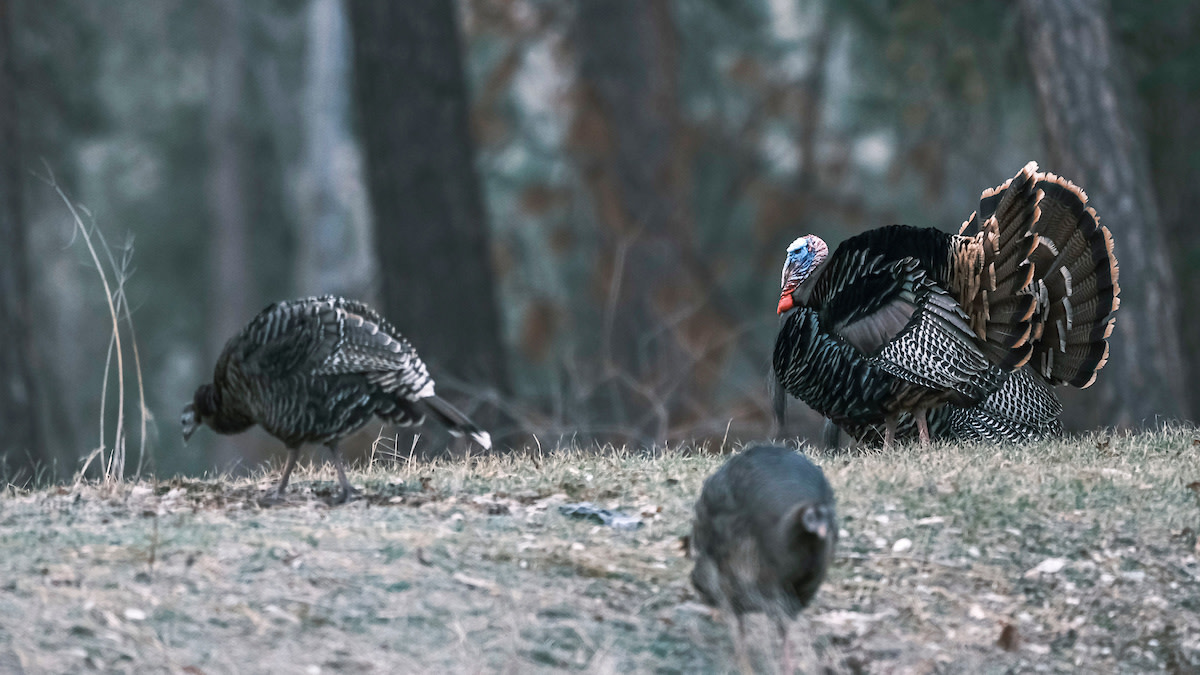
Proactive deer hunters plan their hunting strategy and location with destination food sources in mind. Oddly enough, for many turkey hunters, myself included, a turkey’s diet plays little to no role in deciding where to focus their hunting efforts. When the turkeys go silent, flocks split up, and the going gets tough, keying in on likely food sources is a good strategy to keep in mind.
To learn more about a turkey’s diet, I consulted Dr. Mike Chamberlain, wildlife researcher and professor at the University of Georgia.
“Turkeys are true omnivores and they tend to feed heavily on items they can easily obtain,” Dr. Chamberlain said. “So you tend to see birds using a wide variety of food sources most of the year, with the exception being during winter when those sources become most dominated by hard mast and waste grains. Later, plant and insect communities can change dramatically across the spring turkey season, which will result in birds often shifting what they are consuming to take advantage of an easy and profitable prey source.”
It’s important to keep in mind that the availability of these food sources will vary greatly depending upon your state’s turkey season dates, agricultural availability, and the spring green-up cycle. Of these food sources, here are five staple food sources that turkeys can depend on each spring.
Hard Mast “Acorns and hard mast are important to turkeys throughout the species range,” Dr. Chamberlain said. A lesser-acknowledged wildlife favorite is the American beechnut. Like acorns, beechnuts can be a critical food source for birds throughout winter and into early spring when other food sources aren’t yet available on the landscape. Other hard masts that Eastern birds regularly consume include chestnuts, seeds of white ash, ironwood, hawthorn, witch hazel, and flowering dogwood.
In many Western landscapes, a Merriam’s diet and environment are both dominated by ponderosa and other pine species. According to Chamberlain, like most mast, pine seeds are a staple on a Western bird’s dinner plate. Mature pine trees offer great roosting cover, produce edible hard mast, and often facilitate a good environment for turkeys to bug. Rios also rely on hard mast to supplement their diet. A few favorites include acorns, skunkberry, doveweed, hackberry, and cedar elm.
Soft Mast Soft mast refers to the fruits produced by woody plants like shrubs, trees, and vines. Depending on your location, soft mast may become available late in the turkey season as plants begin flowering and producing fruits.
For states with early openers, soft mast can be critical to a bird’s survival throughout winter and early spring. Fruits from last year’s growing season have dried up and provide a valuable food source for wintering and early spring gobblers. Eastern turkeys may consume fruit from black cherry, wild grape, and spicebush plants, while their Western counterparts browse on fruit from Manzanita, skunkbrush, and juniper plants.
Native Grasses “Grasses, in general, are important to turkeys as they provide succulent green vegetation throughout much of the year,” Dr. Chamberlain said. This is especially true in early spring when green-up has not yet occurred and other food sources are not yet present. Turkeys forage on grass seeds as well as the first tender green shoots.
Native grasses not only provide a readily available food source for spring turkeys, but they also provide great security cover. Young poults thrive in grassland environments, which also provide great bugging opportunities. A few prominent native grasses include big and little bluestem, Indiangrass, switchgrass, buffalo grass, Eastern gamagrass, blue gamma grass, and needlegrass. For those in pursuit of Osceolas, popular grasses include panic grasses, carpet grass, and chufa.
Forbs Forbs are broad leaf flowing plants that lack woody stems. Many hunters casually refer to some forbs as weeds, but they have an important place in a turkey’s diet. Wild clover, sunflowers, milkweed, and ferns fall into the forb category and are a popular food source for many game animals, including turkey. Merriam’s and Rios of the West often seek out alfalfa, sweet clover, sunflower, and vetch.
Invertebrates “Insects are critical to turkeys, both for adults and poults. Newly hatched poults eat only insects for the first few weeks of life, so abundant insects are critical to broods. Likewise, adults obtain protein and water from insects they consume throughout spring and summer,” Dr. Chamberlain said.
Obviously, insect and invertebrate availability will vary from region to region, but one thing is certain, wild turkeys are opportunistic and can eat just about anything that crawls past their beak. Dragonflies, grasshoppers, caterpillars, snails, beetles, worms, and salamanders are all fair game.
“Oddly enough, I once watched a hen stand over a mud hole that was loaded with tadpoles and literally ate so many that her crop was distended with them. I’m not sure you could have crammed another tadpole in that bird’s throat,” Dr. Chamberlain concluded. “Similarly, I’ve also watched several toms wading in shallow water, catching crayfish. They’d duck their heads into the water just like an egret.”
Feature image via John Hafner.






